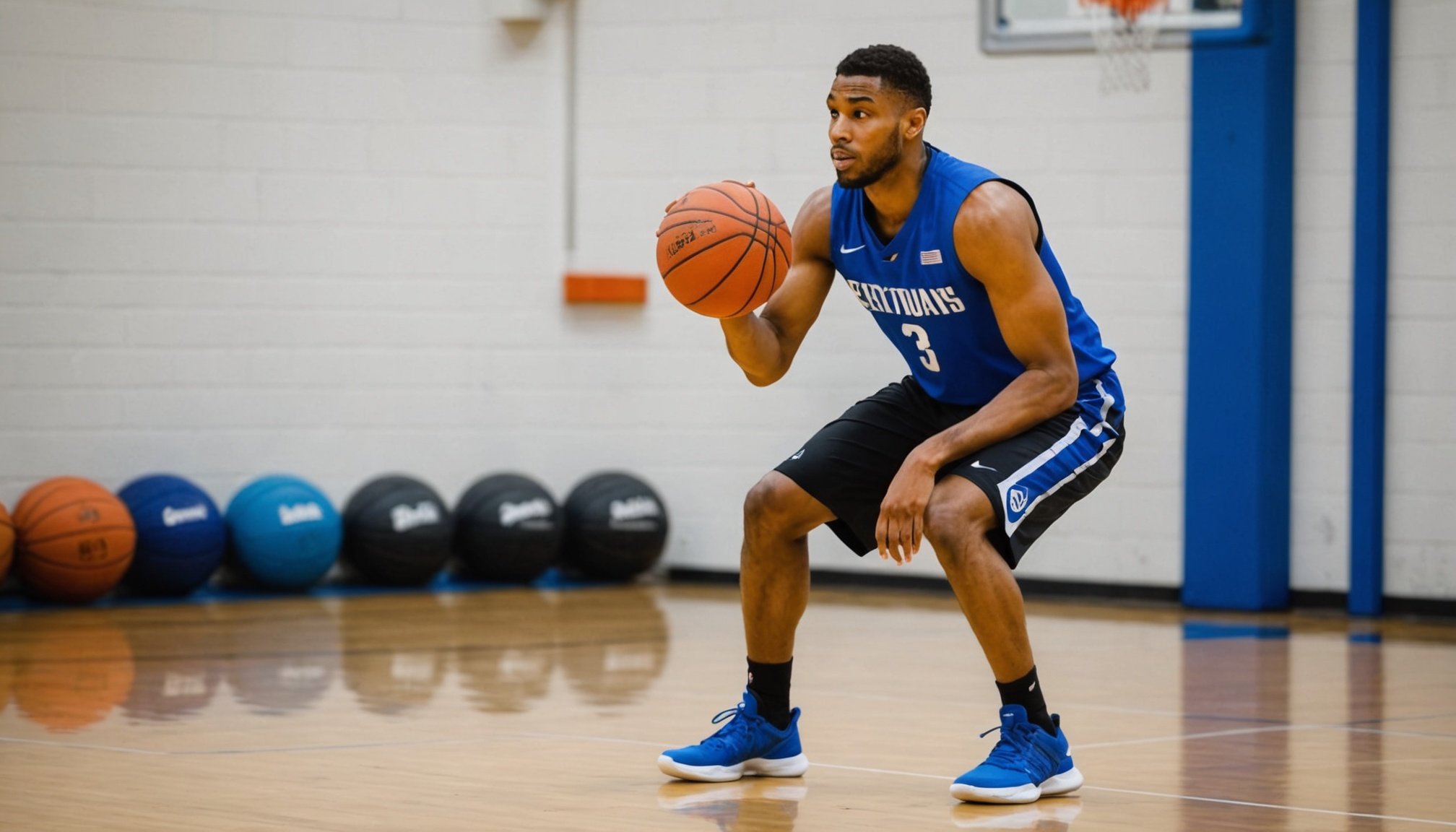Top Exercises to Boost Ankle Stability for UK Basketball Players: Enhance Your Game!
Why Ankle Stability Matters in Basketball
Ankle stability is a crucial component of any basketball player’s arsenal. It’s the foundation upon which all other movements are built, from quick cuts on the court to explosive jumps for rebounds. Without strong, stable ankles, players are at a higher risk of injuries, particularly ankle sprains, which can sideline them for significant periods.
“Basketball is a high-impact sport that demands a lot from your body, especially your ankles,” says Dr. Jane Smith, a sports medicine specialist. “Ankle stability is not just about preventing injuries; it’s also about enhancing performance. When your ankles are stable, you can move more confidently and efficiently on the court.”
Have you seen this : Top Recovery Strategies for UK Basketball Players to Combat Mid-Season Fatigue
Understanding Ankle Anatomy and Common Injuries
Before diving into the exercises, it’s essential to understand the anatomy of the ankle and the common injuries that can occur.
The ankle joint is composed of three bones: the tibia, fibula, and talus. It is supported by a complex network of ligaments, tendons, and muscles. Ankle sprains, which involve the stretching or tearing of these ligaments, are among the most common injuries in basketball.
Also to read : Boosting Performance: Essential Mental Toughness Exercises for UK Basketball Players Facing Fatigue
Here is a brief overview of the common types of ankle sprains:
- Grade 1 Sprain: Mild stretching or microscopic tears of the ligaments.
- Grade 2 Sprain: Moderate tearing of the ligaments.
- Grade 3 Sprain: Severe tearing of the ligaments, which can be very painful and may require surgical intervention.
Key Exercises to Improve Ankle Stability
Improving ankle stability involves a combination of strength training, agility drills, and balance training. Here are some key exercises to incorporate into your training program:
Strength Training
Strength training is vital for building the muscles around the ankle, which in turn enhances stability.
-
Ankle Weights:
-
Wear ankle weights and perform ankle dorsiflexion (lifting your foot up towards your shin) and plantarflexion (pointing your foot down).
-
Do 3 sets of 15-20 repetitions.
-
Resistance Bands:
-
Use resistance bands to perform lateral movements (moving your foot from side to side) and rotational movements (rotating your foot in a circular motion).
-
Do 3 sets of 15-20 repetitions.
Agility Drills
Agility drills help improve your quickness and reaction time, which are critical for basketball.
-
Single Leg Hops:
-
Stand on one leg and hop forward, then switch to the other leg.
-
Do 3 sets of 10-15 repetitions on each leg.
-
Ladder Drills:
-
Use a ladder to perform lateral shuffles, carioca drills (alternating feet in and out of the ladder), and high knees.
-
Do 3 sets of 10-15 repetitions.
Balance Training
Balance training helps improve your overall stability and reduces the risk of injury.
-
Single Leg Balance:
-
Stand on one leg with the other foot lifted off the ground.
-
Hold for 30 seconds to 1 minute and switch legs.
-
Do 3 sets on each leg.
-
BOSU Ball Training:
-
Stand on a BOSU ball with both feet or one foot.
-
Perform squats, lunges, or simply stand and balance.
-
Do 3 sets of 10-15 repetitions.
Detailed Exercise List
Here is a detailed list of exercises you can include in your training program to improve ankle stability:
-
Ankle Alphabet:
-
Draw the alphabet with your toes, starting from A to Z.
-
Do 2 sets.
-
Heel Walks:
-
Walk on your heels for 10-15 steps.
-
Do 3 sets.
-
Toe Walks:
-
Walk on your toes for 10-15 steps.
-
Do 3 sets.
-
Balance on a Foam Pad:
-
Stand on a foam pad with both feet or one foot.
-
Hold for 30 seconds to 1 minute.
-
Do 3 sets on each foot.
-
Yoga Postures:
-
Practice yoga postures like the Warrior 3 (Virabhadrasana III), which helps in improving balance and ankle strength[4].
Table: Comparing Key Exercises for Ankle Stability
| Exercise | Description | Sets & Reps | Benefits |
|---|---|---|---|
| Ankle Weights | Wear ankle weights and perform dorsiflexion and plantarflexion. | 3 sets, 15-20 reps | Strengthens ankle muscles. |
| Resistance Bands | Use resistance bands for lateral and rotational movements. | 3 sets, 15-20 reps | Enhances ankle strength and mobility. |
| Single Leg Hops | Hop forward on one leg and switch to the other. | 3 sets, 10-15 reps | Improves agility and balance. |
| Ladder Drills | Perform lateral shuffles, carioca drills, and high knees using a ladder. | 3 sets, 10-15 reps | Enhances agility and quickness. |
| Single Leg Balance | Stand on one leg with the other foot lifted off the ground. | 3 sets, 30 seconds | Improves balance and stability. |
| BOSU Ball Training | Stand on a BOSU ball and perform squats, lunges, or balance. | 3 sets, 10-15 reps | Enhances balance and stability. |
| Ankle Alphabet | Draw the alphabet with your toes. | 2 sets | Improves ankle mobility and strength. |
| Heel Walks | Walk on your heels for 10-15 steps. | 3 sets | Strengthens ankle and calf muscles. |
| Toe Walks | Walk on your toes for 10-15 steps. | 3 sets | Strengthens toe and ankle muscles. |
| Balance on Foam Pad | Stand on a foam pad with both feet or one foot. | 3 sets, 30 seconds | Improves balance and stability. |
| Yoga Postures | Practice postures like Warrior 3 to improve balance and ankle strength. | Varies | Enhances balance, strength, and flexibility. |
Injury Prevention and Recovery
Injury prevention is a critical aspect of any training program. Here are some tips to help you prevent ankle injuries and recover from them if they do occur:
Preventive Measures
- Warm-Up and Cool-Down: Always warm up before your training sessions and cool down afterwards. This helps in reducing the risk of injury.
- Proper Footwear: Wear shoes that provide adequate support and stability. For basketball, shoes with high ankle support are recommended.
- Strengthen Your Core and Knee: Strong core and knee muscles help in stabilizing your body and reducing the stress on your ankles.
Recovery Techniques
- RICE Method: If you do suffer an ankle sprain, use the RICE method for recovery: Rest, Ice, Compression, and Elevation.
- Physical Therapy: Consult a physical therapist to get personalized exercises and treatments to help you recover faster.
- Gradual Return to Training: When returning to training after an injury, start with low-intensity exercises and gradually increase the intensity.
Practical Insights and Actionable Advice
Here are some practical insights and actionable advice to help you improve your ankle stability and overall performance:
- Consistency is Key: Consistency in your training program is crucial. Aim to practice these exercises at least 3 times a week.
- Listen to Your Body: If you feel any pain or discomfort, stop the exercise immediately. It’s better to err on the side of caution.
- Incorporate Variety: Vary your exercises to avoid plateaus and prevent overuse injuries.
- Seek Professional Help: If you’re unsure about how to perform certain exercises or if you’re recovering from an injury, seek help from a sports trainer or physical therapist.
Real-Life Examples and Anecdotes
Many professional basketball players have emphasized the importance of ankle stability in their training routines. For example, NBA star Steph Curry is known for his rigorous ankle training program, which includes a variety of strength and agility exercises.
“I remember when I first started playing basketball, I used to get ankle sprains all the time,” says Curry. “But once I started focusing on ankle stability, I noticed a significant reduction in injuries and a huge improvement in my performance on the court.”
Improving ankle stability is a multifaceted process that involves strength training, agility drills, balance training, and injury prevention strategies. By incorporating these exercises into your training program, you can significantly enhance your performance on the court, reduce the risk of injuries, and ensure a long and healthy basketball career.
Remember, consistency and patience are key. Start with low-intensity exercises and gradually increase the intensity as your ankles become stronger and more stable. With dedication and the right approach, you can achieve the stability and agility needed to excel in the fast-paced world of basketball.










